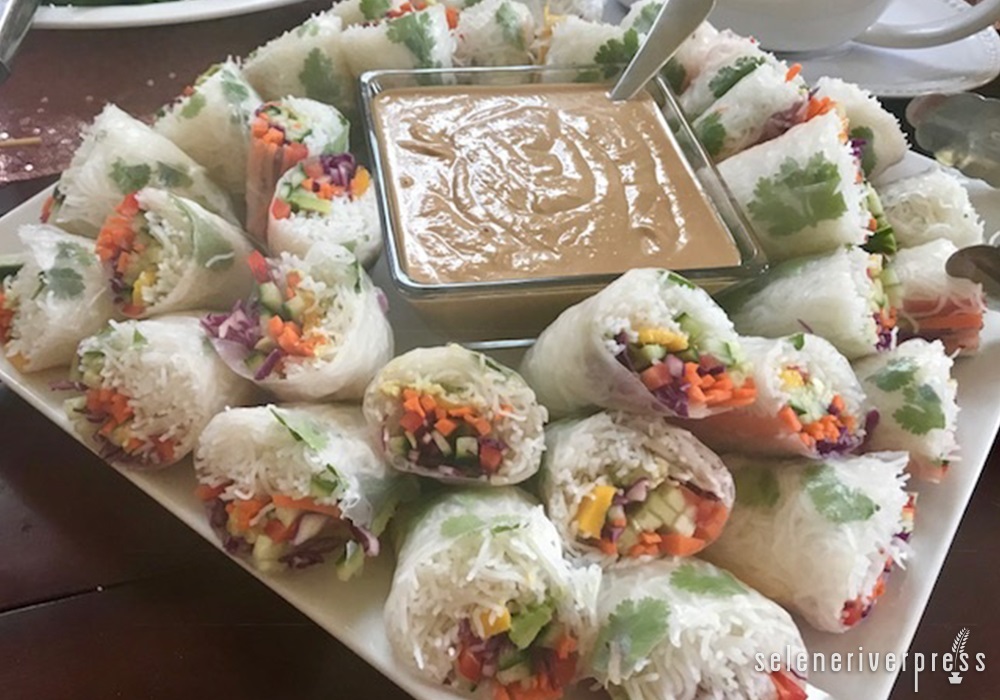Salad rolls, spring rolls, summer rolls, crystal rolls. Whatever you want to call them, I call them delicious!
Honestly, I don’t know if there is a “correct” English translation for the name of these colorful, crunchy concoctions. I’ve referred to them as all of the above, sometimes within the same week. For today’s post, however, and because the ones here are composed of all vegetables, I’m going to stick with “salad rolls.”
These fabulous finger foods—hailing originally from Vietnam and traditionally featuring a filling of prawns, pork, vegetables, and rice noodles—have found a place in the hearts and bellies of people around the world. With that adoration has come countless delicious adaptations.
Salad rolls invoke a special nostalgia for me. I discovered them as a kid, from a little cart at our farmer’s market helmed by a tiny, ancient (at least to my “child’s eyes”) Vietnamese woman. They were one of the first things I learned to make as a kid!
For years after that, I held dear my devotion to these colorful creations and loved to wow and convert people who had never had them before. I tend to guard food secrets, taking a strange satisfaction in having the inside scoop on unfamiliar delicious territory and being the one to share it with others. And while I do occasionally feel disappointed when one of my secrets becomes so widespread that it’s cliché, there are some perks that come with popularity.
Since I started focusing on my health and the quality of food I put in my body, I haven’t been eating salad rolls as often as I used to. Many of the traditional ingredients are things I tend to avoid these days. Items such as refined sugars and processed white rice products, which form the basis of the traditional rolls, simply do not figure in my diet much anymore.
But as salad rolls have expanded in notoriety, so have the offerings available to prepare them. Imagine my surprise and delight when I recently came across both rice noodles and rice paper wrappers made from brown rice. Behold the beauty of when a food secret becomes commonplace! Though salad rolls remain something I don’t eat too regularly, it sure is nice to know there are options to fulfill both my nostalgia and my dietary needs.
There are no real rules for preparing salad rolls. Both traditional and unconventional items can be experimented with as filling ingredients. And though they might look as if they’re time consuming, they’re actually much less work than you might believe. The key is to have all the filling items prepped ahead of time, along with a bowl of warm water for softening the wrappers and a clean cutting board to work on. Filling the rolls takes mere minutes, and once you get the hang of it, the rolling process becomes very methodical and efficient.
I make big batches of these rolls, refrigerate them whole, and then cut them in half right before serving. Of course they’re best fresh, but they’ll keep in the fridge for about three days. Fill them with vegetables, seafood, meats, or even fruit (as I did with mango here) to suit your tastes. This comb of mango and avocado would be especially divine with added shrimp. I try to use at least three different distinct colors in each roll for a color explosion that makes an impressive presentation.
Some peanut sauce recipes call for cooking the sauce, but I’ve kept this one raw for ease of preparation and a fresher zing. Use any leftover sauce as a dressing for salads or a drizzle over a stir fry.
Mango Avocado Salad Rolls with Crunchy Peanut Dipping Sauce
Note: Softening the rice paper is key here. If you leave it in the warm water too long, it will fall apart. Too short, and it won’t be pliable enough. Each brand differs, so check the instructions on the package and tweak the soaking time as necessary as you go.
Makes: 8–12 rolls (depending on size of wrappers)
Prep time: 30 minutes plus time for rolling
Cook time: none
Ingredients
For the peanut sauce (makes about 1¼ cups):
¾ cup creamy, unsweetened peanut butter
3 tablespoons tamari
1½ inch piece of ginger, peeled and finely grated
3 cloves garlic, minced
¼ teaspoon crushed red pepper flakes
9 tablespoons water
2–3 tablespoons fresh lime juice
Powdered or liquid stevia
For the salad rolls:
4 ounces brown or white rice vermicelli
1 carrot, peeled and cut into matchsticks or grated
1 English cucumber, cut into 3-inch matchsticks
1 red pepper, thinly sliced
1 ripe mango, peeled and sliced
½ cup shredded red cabbage
1 avocado, scooped from shell and sliced
1 small handful cilantro, mint, basil, or Thai basil leaves, or a combination of them
8–12 brown or white rice paper spring roll wrappers
2 tablespoons roasted, unsalted peanuts, crushed or chopped, for garnish
Instructions
Prepare peanut sauce:
- Place all the peanut sauce ingredients (peanut butter through stevia) in the bowl of a food processor or blender. (Start with 2 tablespoons of the lime juice and one pinch or drop of the stevia. If you prefer a more traditional sweetener, use a teaspoon or so of coconut palm sugar in place of the stevia.) Blend until thick and creamy, about 30–60 seconds. Taste and add additional lime juice and sweetener if desired. (I like my peanut sauce to be a nice balance of tart and sweet.) For a spicier sauce, add more red pepper flakes. Refrigerate until serving.
Prepare salad rolls:
- Cook vermicelli according to package instructions; drain and run under cold water until chilled. Drain well and set aside. Arrange all filling ingredients except herbs (carrot through avocado) on a plate or baking sheet set in your workspace. Place herb leaves in a small bowl and set bowl next to other filling ingredients. Fill a large bowl with warm water (big enough to fit a rice paper wrapper) and set it in your workspace. Have a clean and dry cutting board in front of you.
- Place one rice paper wrapper in the water and leave until just softened, about 5–10 seconds. Remove rice paper from water and let excess moisture drip back into bowl. Lay soaked rice paper flat on your cutting board. Place a couple of leaves of the herb of your choice onto bottom of paper. (You want to keep your fillings near the center of the rice paper, like you’re making a burrito.)
- Add a small handful of vermicelli to the center of the paper on top of the herbs, spreading the noodles out in a rectangle that is about 1 inch across (from top to bottom) and leaves a gap of at least 1 inch on each side, between the ends of the noodles and the edge of the paper. The amount needed will depend on the size of your paper.
- Now add the remaining fillings. Place 1 or 2 sticks each of cucumber, mango, avocado, and red pepper atop noodles, along with a large pinch each of carrot and cabbage. (You need to fit a little of every filling, so envision how much your paper can hold and adjust accordingly.) Once all the filling ingredients are inside, fold over each side of the rice paper to enclose the filling and roll it up from the bottom (the side closest to you) to the top. The moisture from the paper will seal it. Be sure to keep all the filling completely inside, since any protruding filling will prevent the top from sealing properly.
- Place filled roll, seam side down, on a plate or baking sheet and set aside. Repeat process with each rice paper wrapper. Store the finished rolls in the refrigerator until chilled. Serve chilled rolls with peanut sauce for dipping, topping sauce with chopped peanuts immediately before serving.
Image from Briana Goodall.



